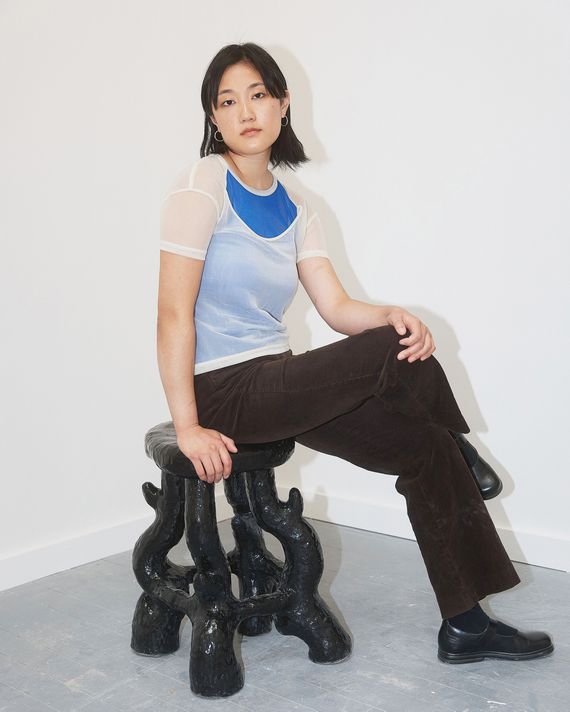
It was during a shopping trip to Costco, of all places, when inspiration hit Ellen Pong. She was transfixed by an egg-shaped chair in the massage chair section that swallows anyone who sits in it. She was a bit sore from her new rock-climbing hobby, so she took a seat. It wasn’t comfortable. Looking at all the chairs together, she concluded that what made them all similar is that they were all painful to sit in. This inspired one of her first ceramic furniture designs: a periwinkle-blue stool adorned with nubs and tentacles — borrowed from the kinds of shapes you find on manual-massage tools — that you can press against your muscles. She describes it as “this weird alien massage stool device.”
Pong, 24, is a self-taught freelance graphic designer who only began making ceramic furniture last year. She never went to art school (she studied art history and took ceramics classes on the side), and while she says clay isn’t “the most practical means of making furniture,” it’s a more accessible medium than wood or metal, which require more sophisticated tools, so experimenting is low-stakes. “I don’t know how to build a house, or a car, or make furniture by traditional means, but this [is] a strength in some ways,” she says. “Making ceramic furniture is a dumb idea, but there’s so much possibility in being naïve. It’s much more exciting than the alternative.” Her body of work is relatively small, but already demonstrates a strong pattern of making playful objects that play with the literal, like a dimpled yellow chair with a back shaped like a keyhole simply named “Keyhole Chair.”
Her process usually begins with seeing something and sketching out how it might become a 3-D object, then sculpting it in her studio, Permanent Maintenance, a communal art studio in Ridgewood. “I am at a point where my practice isn’t one cohesive thing,” Pong says. “I’m still exploring many different avenues that I feel like are unfinished lines of thought … I get bored easily so I like to switch it up and go in different directions.” Plus, if a concept doesn’t work out, it’s not a big deal. “Sometimes I’ll make something and I’ll have to destroy it if I’m not 100 percent happy with it,” she says. “There is no room in my mind, or studio, to have those things.”
She walked us through a few of her recent works that were good enough to keep, starting with the Massage Stool.
Massage Stool
“I would have never attempted to make a massage chair before I came to the conclusion that a massage chair is just an uncomfortable chair. It’s interesting to me that being able to categorize something can make it knowable to you in a new way.”
Antipastissue
“I was scrolling through an event venue’s website and they had a photo of a huge charcuterie spread on it. The meat was arranged in a way that looked like fabric draping over a table. I thought, This is so gross and weird, but also kind of incredible. I made a mental inventory of the image. It was just burned in my mind. I don’t know how it became a tissue-box holder. I thought this idea of meat as fabric was neat and worth investigating. It is so creepy! Like, the idea of sliced meats. It is so skinlike in a weird way, so there’s a bodily connection between tissue and meat.”
Thorn Stool
“This stool was indirectly influenced by the weird and twisted organic forms I saw going on hikes near Seattle. I took the landscape for granted growing up around there and looked at it all the time. It wasn’t until I watched Twin Peaks for the first time during quarantine that I realized the Pacific Northwest is aestheticized in a particular way. The show depicted the area with a kind of mystery.”
Squiggle Chair
“When I made this, I had just moved into a new apartment and was thinking about what kind of stuff I would like to have in it. I was also looking at typography and thinking about how I could translate something 2-D into 3-D, which is a challenge. I initially conceived of the chair as a line drawing from its profile and extruded it into 3-D space. That’s how I made it: from a slab of clay I built outward. I knew I wanted the seat to be red, so it would be different from the other pieces I had in the room. When I made some renderings of the chair in Photoshop, it became clear that I needed something graphic on it, that it would be a missed opportunity not to have something there. I don’t know how I came to the images there. Maybe I saw a cute picture of a frog?”








